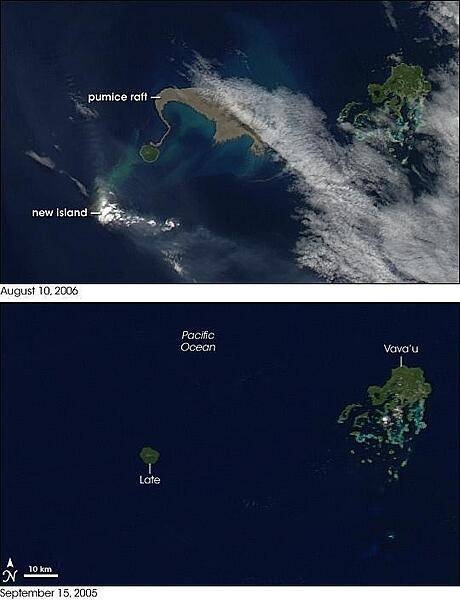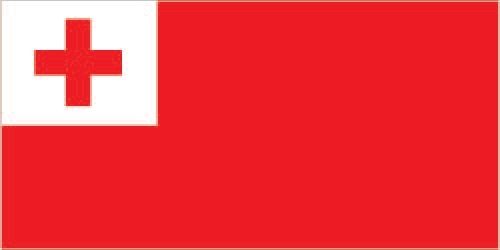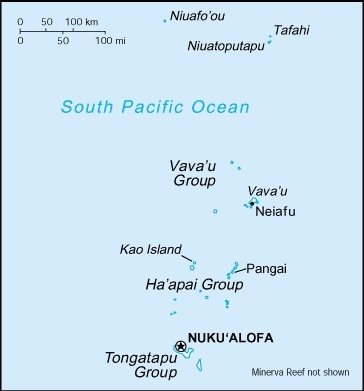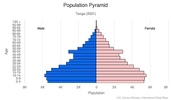Introduction
Background
The first humans arrived in Tonga around 1000 B.C. The islands’ politics were probably highly centralized under the Tu’i Tonga, or Tongan king, by A.D. 950, and by 1200, the Tu’i Tonga had expanded his influence throughout Polynesia and into Melanesia and Micronesia. The Tongan Empire began to decline in the 1300s, descending into civil wars, a military defeat to Samoa, and internal political strife that saw successive leaders assassinated. By the mid-1500s, some Tu’i Tongans were ethnic Samoan and day-to-day administration of Tonga was transferred to a new position occupied by ethnic Tongans.
Dutch sailors explored the islands in the 1600s and British Captain James COOK visited Tonga three times in the 1770s, naming them the Friendly Islands for the positive reception he thought he received, even though the Tongans he encountered were plotting ways to kill him. In 1799, Tonga fell into a new round of civil wars over succession. Wesleyan missionaries arrived in 1822, quickly converting the population. In the 1830s, a low-ranking chief from Ha’apai began to consolidate control over the islands and won the support of the missionaries by declaring that he would dedicate Tonga to God. The chief soon made alliances with leaders on most of the other islands and was crowned King George TUPOU I in 1845, establishing the only still-extant Polynesian monarchy. Tupou I declared Tonga a constitutional monarchy in 1875 and his successor, King George TUPOU II, agreed to enter a protectorate agreement with the UK in 1900 after rival Tongan chiefs tried to overthrow him. As a protectorate, Tonga never completely lost its indigenous governance, but it did become more isolated and the social hierarchy became more stratified between a group of nobles and a large class of commoners. Today, about one third of parliamentary seats are reserved for nobles.
Queen Salote TUPOU III negotiated the end of the protectorate in 1965, which was achieved under King TUPOU, who in 1970 withdrew from the protectorate and joined the Commonwealth of Nations. A prodemocracy movement gained steam in the early 2000s, led by future Prime Minister ‘Akilisi POHIVA, and in 2006, riots broke out in Nuku’alofa to protest the lack of progress on prodemocracy legislation. To appease the activists, in 2008, King George TUPOU V announced he was relinquishing most of his powers leading up to parliamentary elections in 2010; he died in 2012 and was succeeded by his brother ‘Aho’eitu TUPOU VI. Tropical Cyclone Gita, the strongest-ever recorded storm to impact Tonga, hit the islands in February 2018 causing extensive damage.
Visit the Definitions and Notes page to view a description of each topic.
Geography
Location
Oceania, archipelago in the South Pacific Ocean, about two-thirds of the way from Hawaii to New Zealand
Geographic coordinates
20 00 S, 175 00 W
Map references
Oceania
Land boundaries
total: 0 km
Coastline
419 km
Maritime claims
territorial sea: 12 nm
exclusive economic zone: 200 nm
continental shelf: 200-m depth or to the depth of exploitation
Climate
tropical; modified by trade winds; warm season (December to May), cool season (May to December)
Terrain
mostly flat islands with limestone bedrock formed from uplifted coral formation; others have limestone overlying volcanic rock
Elevation
highest point: Kao Volcano on Kao Island 1,046 m
lowest point: Pacific Ocean 0 m
Natural resources
arable land, fish
Land use
agricultural land: 43.1% (2018 est.)
arable land: 22.2% (2018 est.)
permanent crops: 15.3% (2018 est.)
permanent pasture: 5.6% (2018 est.)
forest: 12.5% (2018 est.)
other: 44.4% (2018 est.)
Irrigated land
0 sq km (2012)
Population distribution
over two-thirds of the population lives on the island of Tongatapu; only 45 of the nation's 171 islands are occupied
Natural hazards
cyclones (October to April); earthquakes and volcanic activity on Fonuafo'ou
volcanism: moderate volcanic activity; Fonualei (180 m) has shown frequent activity in recent years, while Niuafo'ou (260 m), which last erupted in 1985, has forced evacuations; other historically active volcanoes include Late and Tofua
Geography - note
the western islands (making up the Tongan Volcanic Arch) are all of volcanic origin; the eastern islands are nonvolcanic and are composed of coral limestone and sand
People and Society
Nationality
noun: Tongan(s)
adjective: Tongan
Ethnic groups
Tongan 97%, part-Tongan 0.8%, other 2.2%, unspecified <0.1% (2016 est.)
Languages
Tongan and English 76.8%, Tongan, English, and other language 10.6%, Tongan only (official) 8.7%, English only (official) 0.7%, other 1.7%, none 2.2% (2016 est.)
note: data represent persons aged 5 and older who can read and write a simple sentence in Tongan, English, or another language
Religions
Protestant 64.1% (includes Free Wesleyan Church 35%, Free Church of Tonga 11.9%, Church of Tonga 6.8%, Assembly of God 2.3%, Seventh Day Adventist 2.2%, Tokaikolo Christian Church 1.6%, other 4.3%), Church of Jesus Christ 18.6%, Roman Catholic 14.2%, other 2.4%, none 0.5%, unspecified 0.1% (2016 est.)
Age structure
0-14 years: 32% (male 17,250/female 16,698)
15-24 years: 19.66% (male 10,679/female 10,175)
25-54 years: 35.35% (male 18,701/female 18,802)
55-64 years: 6.17% (male 3,345/female 3,202)
65 years and over: 6.83% (male 3,249/female 3,994) (2020 est.)
Dependency ratios
total dependency ratio: 68.6
youth dependency ratio: 58.6
elderly dependency ratio: 10
potential support ratio: 10 (2020 est.)
Median age
total: 24.1 years
male: 23.6 years
female: 24.5 years (2020 est.)
Net migration rate
-17.96 migrant(s)/1,000 population (2021 est.)
country comparison to the world: 228Population distribution
over two-thirds of the population lives on the island of Tongatapu; only 45 of the nation's 171 islands are occupied
Urbanization
urban population: 23.1% of total population (2021)
rate of urbanization: 0.99% annual rate of change (2020-25 est.)
Major urban areas - population
23,000 NUKU'ALOFA (2018)
Sex ratio
at birth: 1.03 male(s)/female
0-14 years: 1.03 male(s)/female
15-24 years: 1.05 male(s)/female
25-54 years: 0.99 male(s)/female
55-64 years: 1.04 male(s)/female
65 years and over: 0.81 male(s)/female
total population: 1.01 male(s)/female (2020 est.)
Mother's mean age at first birth
24.9 years (2012 est.)
note: median age at first birth among women 25-49
Maternal mortality ratio
52 deaths/100,000 live births (2017 est.)
country comparison to the world: 94Infant mortality rate
total: 12.73 deaths/1,000 live births
male: 13.77 deaths/1,000 live births
female: 11.65 deaths/1,000 live births (2021 est.)
Life expectancy at birth
total population: 77.29 years
male: 75.63 years
female: 78.99 years (2021 est.)
Contraceptive prevalence rate
29.3% (2019)
Drinking water source
improved: urban: 100% of population
rural: 100% of population
total: 100% of population
unimproved: urban: 0% of population
rural: 0% of population
total: 0% of population (2017 est.)
Current Health Expenditure
5.1% (2018)
Physicians density
0.54 physicians/1,000 population (2013)
Sanitation facility access
improved: urban: 96.6% of population
rural: 93.6% of population
total: 94.5% of population
unimproved: urban: 3.4% of population
rural: 6.4% of population
total: 5.5% of population (2017 est.)
Major infectious diseases
degree of risk: high (2020)
food or waterborne diseases: bacterial diarrhea
vectorborne diseases: malaria
Literacy
definition: can read and write Tongan and/or English
total population: 99.4%
male: 99.4%
female: 99.5% (2018)
School life expectancy (primary to tertiary education)
total: 16 years
male: 15 years
female: 17 years (2020)
Unemployment, youth ages 15-24
total: 8.9%
male: 5.7%
female: 13.1% (2018)
Environment
Environment - current issues
deforestation from land being cleared for agriculture and settlement; soil exhaustion; water pollution due to salinization, sewage, and toxic chemicals from farming activities; coral reefs and marine populations threatened
Environment - international agreements
party to: Biodiversity, Climate Change, Climate Change-Kyoto Protocol, Climate Change-Paris Agreement, Desertification, Endangered Species, Hazardous Wastes, Law of the Sea, Marine Dumping-London Convention, Marine Dumping-London Protocol, Marine Life Conservation, Nuclear Test Ban, Ozone Layer Protection, Ship Pollution
signed, but not ratified: none of the selected agreements
Air pollutants
particulate matter emissions: 10.08 micrograms per cubic meter (2016 est.)
carbon dioxide emissions: 0.13 megatons (2016 est.)
methane emissions: 0.12 megatons (2020 est.)
Climate
tropical; modified by trade winds; warm season (December to May), cool season (May to December)
Land use
agricultural land: 43.1% (2018 est.)
arable land: 22.2% (2018 est.)
permanent crops: 15.3% (2018 est.)
permanent pasture: 5.6% (2018 est.)
forest: 12.5% (2018 est.)
other: 44.4% (2018 est.)
Urbanization
urban population: 23.1% of total population (2021)
rate of urbanization: 0.99% annual rate of change (2020-25 est.)
Revenue from forest resources
forest revenues: 0.03% of GDP (2018 est.)
country comparison to the world: 137Major infectious diseases
degree of risk: high (2020)
food or waterborne diseases: bacterial diarrhea
vectorborne diseases: malaria
Waste and recycling
municipal solid waste generated annually: 17,238 tons (2012 est.)
Total renewable water resources
0 cubic meters (2017 est.)
Government
Country name
conventional long form: Kingdom of Tonga
conventional short form: Tonga
local long form: Pule'anga Fakatu'i 'o Tonga
local short form: Tonga
former: Friendly Islands
etymology: "tonga" means "south" in the Tongan language and refers to the country's geographic position in relation to central Polynesia
Government type
constitutional monarchy
Capital
name: Nuku'alofa
geographic coordinates: 21 08 S, 175 12 W
time difference: UTC+13 (18 hours ahead of Washington, DC, during Standard Time)
daylight saving time: +1hr, begins first Sunday in November; ends second Sunday in January
etymology: composed of the words "nuku," meaning "residence or abode," and "alofa," meaning "love," to signify "abode of love"
Administrative divisions
5 island divisions; 'Eua, Ha'apai, Ongo Niua, Tongatapu, Vava'u
Independence
4 June 1970 (from UK protectorate status)
National holiday
Official Birthday of King TUPOU VI, 4 July (1959); note - actual birthday of the monarch is 12 July 1959, 4 July (2015) is the day the king was crowned; Constitution Day (National Day), 4 November (1875)
Constitution
history: adopted 4 November 1875, revised 1988, 2016
amendments: proposed by the Legislative Assembly; passage requires approval by the Assembly in each of three readings, the unanimous approval of the Privy Council (a high-level advisory body to the monarch), the Cabinet, and assent to by the monarch; revised 1988; amended many times, last in 2013
Legal system
English common law
International law organization participation
has not submitted an ICJ jurisdiction declaration; non-party state to the ICCt
Citizenship
citizenship by birth: no
citizenship by descent only: the father must be a citizen of Tonga; if a child is born out of wedlock, the mother must be a citizen of Tonga
dual citizenship recognized: yes
residency requirement for naturalization: 5 years
Suffrage
21 years of age; universal
Executive branch
chief of state: King TUPOU VI (since 18 March 2012); Heir Apparent Crown Prince Siaosi Manumataogo 'Alaivahamama'o 'Ahoeitu Konstantin Tuku'aho, son of the king (born 17 September 1985); note - on 18 March 2012, King George TUPOU V died and his brother, Crown Prince TUPOUTO'A Lavaka, assumed the throne as TUPOU VI
head of government: Prime Minister-Designate Siaosi SOVALENI (since 15 November 2021)
cabinet: Cabinet nominated by the prime minister and appointed by the monarch
elections/appointments: the monarchy is hereditary; prime minister and deputy prime minister indirectly elected by the Legislative Assembly and appointed by the monarch; election last held on 15 November 2021 (next to be held in in November 2025)
election results: Siaosi SOVALENI elected prime minister-designate by the Legislative Assembly; Siaosi SOVALENI 16 votes, Aisake EKE 10
note: a Privy Council advises the monarch
Legislative branch
description: unicameral Legislative Assembly or Fale Alea (up to 30 seats; - 26 for the 2021-25 term); 17 people's representatives directly elected in single-seat constituencies by simple majority vote, and 9 indirectly elected by hereditary leaders; members serve 4-year terms)
elections: last held on 18 November 2021 (next to be held in November 2025)
election results: percent of vote - NA; seats by party (elected members) - Democratic Party of the Friendly Islands 3, Tonga People's Party 1, independent 13; composition (elected members) - men 17, women 0, percent of women 0%
Judicial branch
highest courts: Court of Appeal (consists of the court president and a number of judges determined by the monarch); note - appeals beyond the Court of Appeal are brought before the King in Privy Council, the monarch's advisory organ that has both judicial and legislative powers
judge selection and term of office: judge appointments and tenures made by the King in Privy Council and subject to consent of the Legislative Assembly
subordinate courts: Supreme Court; Magistrates' Courts; Land Courts
Political parties and leaders
Democratic Party of the Friendly Islands
People's Democratic Party or PDP [Tesina FUKO]
Sustainable Nation-Building Party [Sione FONUA]
Tonga Democratic Labor Party
Tonga Human Rights and Democracy Movement or THRDM
Tonga People's Party or PAK (Paati ʻa e Kakai ʻo Tonga) [Pohiva TU'I'ONETOA] (split from Democratic Party of the Friendly Islands)
International organization participation
ACP, ADB, AOSIS, C, FAO, G-77, IBRD, ICAO, ICRM, IDA, IFAD, IFC, IFRCS, IHO, IMF, IMO, IMSO, Interpol, IOC, IPU, ITU, ITUC (NGOs), OPCW, PIF, Sparteca, SPC, UN, UNCTAD, UNESCO, UNIDO, UPU, WCO, WHO, WIPO, WMO, WTO
Diplomatic representation in the US
chief of mission: Ambassador Viliami Va’inga TONE (since 20 April 2021)
chancery: 250 East 51st Street, New York, NY 10022
telephone: [1] (917) 369-1025
FAX: [1] (917) 369-1024
email address and website:
tongaunmission@aol.com
consulate(s) general: San Francisco
Diplomatic representation from the US
embassy: the US does not have an embassy in Tonga; the US Ambassador to Fiji is accredited to Tonga
Flag description
red with a bold red cross on a white rectangle in the upper hoist-side corner; the cross reflects the deep-rooted Christianity in Tonga, red represents the blood of Christ and his sacrifice, and white signifies purity
National symbol(s)
red cross on white field, arms equal length; national colors: red, white
National anthem
name: "Ko e fasi `o e tu"i `o e `Otu Tonga" (Song of the King of the Tonga Islands)
lyrics/music: Uelingatoni Ngu TUPOUMALOHI/Karl Gustavus SCHMITT
note: in use since 1875; more commonly known as "Fasi Fakafonua" (National Song)
Economy
Economic overview
Tonga has a small, open island economy and is the last constitutional monarchy among the Pacific Island countries. It has a narrow export base in agricultural goods. Squash, vanilla beans, and yams are the main crops. Agricultural exports, including fish, make up two-thirds of total exports. Tourism is the second-largest source of hard currency earnings following remittances. Tonga had 53,800 visitors in 2015. The country must import a high proportion of its food, mainly from New Zealand.
The country remains dependent on external aid and remittances from overseas Tongans to offset its trade deficit. The government is emphasizing the development of the private sector, encouraging investment, and is committing increased funds for health care and education. Tonga's English-speaking and educated workforce offers a viable labor market, and the tropical climate provides fertile soil. Renewable energy and deep-sea mining also offer opportunities for investment.
Tonga has a reasonably sound basic infrastructure and well developed social services. But the government faces high unemployment among the young, moderate inflation, pressures for democratic reform, and rising civil service expenditures.
Real GDP (purchasing power parity)
$670 million note: data are in 2017 dollars (2019 est.)
$660 million note: data are in 2017 dollars (2018 est.)
$660 million (2017 est.)
note: data are in 2017 dollars
Real GDP growth rate
2.5% (2017 est.)
4.2% (2016 est.)
3.5% (2015 est.)
Real GDP per capita
$6,400 note: data are in 2017 dollars (2019 est.)
$6,400 note: data are in 2017 dollars (2018 est.)
$6,472 (2017 est.)
note: data are in 2017 dollars
GDP (official exchange rate)
$455 million (2017 est.)
Inflation rate (consumer prices)
7.4% (2017 est.)
2.6% (2016 est.)
GDP - composition, by sector of origin
agriculture: 19.9% (2017 est.)
industry: 20.3% (2017 est.)
services: 59.8% (2017 est.)
GDP - composition, by end use
household consumption: 99.4% (2017 est.)
government consumption: 21.9% (2017 est.)
investment in fixed capital: 24.1% (2017 est.)
investment in inventories: 0% (2017 est.)
exports of goods and services: 22.8% (2017 est.)
imports of goods and services: -68.5% (2017 est.)
Agricultural products
coconuts, gourds, cassava, sweet potatoes, vegetables, yams, taro, roots/tubers nes, plantains, lemons/limes
Industries
tourism, construction, fishing
Labor force - by occupation
agriculture: 2,006% (2006 est.)
industry: 27.5% (2006 est.)
services: 2,006% (2006 est.)
Population below poverty line
22.5% (2010 est.)
Gini Index coefficient - distribution of family income
37.6 (2015 est.)
country comparison to the world: 77Household income or consumption by percentage share
lowest 10%: NA
highest 10%: NA
Budget
revenues: 181.2 million (2017 est.)
expenditures: 181.2 million (2017 est.)
Fiscal year
1 July - 30 June
Current account balance
-$53 million (2017 est.)
-$30 million (2016 est.)
Exports
$90 million note: data are in current year dollars (2020 est.)
$110 million note: data are in current year dollars (2019 est.)
$100 million note: data are in current year dollars (2018 est.)
Exports - partners
United States 38%, South Korea 18%, Australia 14%, New Zealand 14%, Japan 6%, (2019)
Exports - commodities
squash, fish, various fruits and nuts, antiques, coral and shells (2019)
Imports
$300 million note: data are in current year dollars (2020 est.)
$330 million note: data are in current year dollars (2019 est.)
$320 million note: data are in current year dollars (2018 est.)
Imports - partners
Fiji 29%, New Zealand 23%, China 14%, United States 8%, Australia 6%, Japan 6% (2019)
Imports - commodities
refined petroleum, poultry meats, audio equipment, mutton, goat meat, broadcasting equipment (2019)
Reserves of foreign exchange and gold
$198.5 million (31 December 2017 est.)
$176.5 million (31 December 2016 est.)
Debt - external
$189.9 million (31 December 2017 est.)
$198.2 million (31 December 2016 est.)
Exchange rates
pa'anga (TOP) per US dollar -
2.27015 (2020 est.)
2.29095 (2019 est.)
2.22717 (2018 est.)
2.106 (2014 est.)
1.847 (2013 est.)
Unemployment, youth ages 15-24
total: 8.9%
male: 5.7%
female: 13.1% (2018)
Energy
Electricity access
electrification - total population: 98.9% (2018)
electrification - urban areas: 98.9% (2018)
electrification - rural areas: 98.9% (2018)
Electricity - installed generating capacity
20,300 kW (2016 est.)
country comparison to the world: 203Electricity - from fossil fuels
74% of total installed capacity (2016 est.)
country comparison to the world: 98Electricity - from nuclear fuels
0% of total installed capacity (2017 est.)
country comparison to the world: 196Electricity - from hydroelectric plants
0% of total installed capacity (2017 est.)
country comparison to the world: 205Electricity - from other renewable sources
26% of total installed capacity (2017 est.)
country comparison to the world: 27Communications
Telephones - fixed lines
total subscriptions: 6,637 (2019)
subscriptions per 100 inhabitants: 6.35 (2019 est.)
Telephones - mobile cellular
total subscriptions: 62,104 (2019)
subscriptions per 100 inhabitants: 59.43 (2019 est.)
Telecommunication systems
general assessment: high speed Internet provided by 3 MNOs, has subsequently allowed for better health care services, faster connections for education and growing e-commerce services; in 2018 new 4G LTE network; fixed-line teledensity has dropped given mobile subscriptions; mobile technology dominates given the island's geography; satellite technology is widespread and is important especially in areas away from the city; the launch in 2019 of the Kacific-1 broadband satellite has made broadband more widely available for around 89 remote communities (2020)
domestic: fixed-line 6 per 100 persons and mobile-cellular teledensity 59 telephones per 100; fully automatic switched network (2019)
international: country code - 676; landing point for the Tonga Cable and the TDCE connecting to Fiji and 3 separate Tonga islands; satellite earth station - 1 Intelsat (Pacific Ocean) (2020)
note: the COVID-19 pandemic continues to have a significant impact on production and supply chains globally; since 2020, some aspects of the telecom sector have experienced downturn, particularly in mobile device production; many network operators delayed upgrades to infrastructure; progress towards 5G implementation was postponed or slowed in some countries; consumer spending on telecom services and devices was affected by large-scale job losses and the consequent restriction on disposable incomes; the crucial nature of telecom services as a tool for work and school from home became evident, and received some support from governments
Broadcast media
1 state-owned TV station and 3 privately owned TV stations; satellite and cable TV services are available; 1 state-owned and 5 privately owned radio stations; Radio Australia broadcasts available via satellite (2019)
Internet users
total: 43,800 (2021 est.)
percent of population: 41.25% (2019 est.)
Broadband - fixed subscriptions
total: 3,703 (2019)
subscriptions per 100 inhabitants: 3.54 (2019 est.)
Transportation
National air transport system
number of registered air carriers: 1 (2020)
inventory of registered aircraft operated by air carriers: 1
Airports - with paved runways
total: 1
2,438 to 3,047 m: 1 (2019)
Airports - with unpaved runways
total: 5
1,524 to 2,437 m: 1
914 to 1,523 m: 3
under 914 m: 1 (2013)
Roadways
total: 680 km (2011)
paved: 184 km (2011)
unpaved: 496 km (2011)
Merchant marine
total: 32
by type: container ship 4, general cargo 13, oil tanker 1, other 14 (2021)
Ports and terminals
major seaport(s): Nuku'alofa, Neiafu, Pangai
Military and Security
Military and security forces
Tonga Defense Services (His Majesty's Armed Forces): Joint Force headquarters, Territorial Forces, Land Force, Tonga Navy, Training Wing, Air Wing, and Support Unit (2021)
Military and security service personnel strengths
the Tonga Defense Services have approximately 500 personnel (2021)
Military equipment inventories and acquisitions
the Tonga military's inventory includes mostly light weapons and equipment from European (primarily the UK) countries and the US, as well as naval patrol vessels from Australia; Australia is the only supplier of military systems since 2010 (2020)
Military service age and obligation
Volunteers, 18-25; no conscription (2019)
Military - note
Tonga participated in World War I as part of the New Zealand Expeditionary Force, but the Tonga Defense Force (TDF) was not established until 1939 at the beginning of World War II; in 1943, New Zealand helped train about 2,000 Tongan troops who saw action in the Solomon Islands; the TDF was disbanded at the end of the war, but was reactivated in 1946 as the Tonga Defense Services (TDS); in 2013, the name of the TDS was changed to His Majesty’s Armed Forces of Tonga (HMAF); Tongan troops deployed to Iraq from 2004-2008 and Afghanistan to support UK forces from 2010-2014





